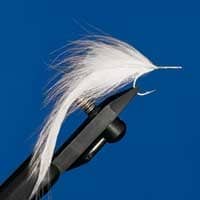
It’s no secret that large menhaden are a surefire food source for monster striped bass. But creating a full-profile bunker fly that casts well in various conditions, performs effectively and can be used with lighter fly rods can be a significant challenge.
During May, 8- to 10-inch bunker invade brackish rivers, yet it is impractical to toss large bunker flies with a 7-weight line, the most popular choice considering the sheltered eddies and coves.
Many think that only small bass swim in these estuaries, but big ones show up as well, targeting both the large menhaden and herring. Both these food sources have a similar physical shape, and flies that reflect them are much more likely to attract the larger bass. Illusion was the key if I was to develop a light, large bunker/herring fly to be cast with a 7-weight. So I selected an amalgam of materials for the Sloopy Droopy Bucktail Bunker that are soft, fully action-oriented and have unique characteristics.
I included a spey chicken feather known as Bird Fur. This plumage mimics Marabou at the base and extra-select craft fur at the business end. When the fly is paused, it gives the illusion of bushy bulk, yet it imparts a slim silhouette on the retrieve.
I chose 7-inch lengths of Mirage Flash-abou to continue the deception. These fine, multicolor strands have distinct reflective properties that generate fluctuating colors, effectively adapting to the tone of their surroundings while casting an illusory glow.
Combining and mixing various shades of bucktail creates the perception of a large bunker while still indicating a herring. A topping of peacock herl and DNA Holofusion, a mobile material that shimmers gently in the water, completes the wing.
This pattern required a strong, short-shank hook, and the Gamakatsu SC15 balances it well. White-iris, black-pupil eyes painted over gray thread are highly visible.
When bunker are present in rivers, I focus on overcast, still days. During these times, it’s common to see large bass boil behind the high-riding Sloopy Droopy before rushing in. I named this pattern such because the chosen materials provide a long, slouchy appearance. I have duped springtime river bass up to 20 pounds on this fly, and it has also produced in the surf during the fall migration.
Materials
HOOK: _2/0 Gamakatsu SC15.
_THREAD: Danville 6/0 gray.
BODY AND BELLY: Olive, lavender, yellow, gray and white bucktail.
TOPPING: DNA Holofusion, olive and peacock herl.
TAIL: Three white Bird Fur feathers.
FLASH: Mirage Flashabou, opal/silver and opal/black.
EYES: White/black, painted or stick-on.
GLUE: Hard as Hull cement.
Tying Instructions
| Step 1: Tie in a 3-inch clump of sparse, white bucktail from midway under the hook shank to the hook bend. Above the bucktail, tie in three white 5-inch Bird Fur feathers followed by several strands of 7-inch opal/silver flash on each side of the hook bend. Taper thread and cement wraps. | |
| Step 2: In front of the tapered thread, tie a small 3-inch clump of white bucktail to the underside of the hook shank, then a larger bundle of 4-inch mixed yellow and gray to the top of the hook shank. (The previously tapered thread will ensure the bucktail flares.) Tie about six strands of opal/silver Mirage Flashabou on top of the yellow-and-gray bucktail mix. Taper thread and cement wraps. |
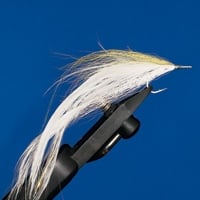
| | Step 3: Tie a mixture of 4-inch lavender and olive bucktail above the strands of opal/silver flash, again, right in front of previously tapered threads.|
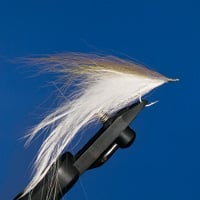
| | Step 4: Complete the wing by tying about six 7-inch strands of opal/black Mirage Flashabou, a few 6-inch strands of olive DNA Holofusion and about eight 3- to 4-inch peacock herl strands above the lavender-olive mix. Taper thread to hook eye, keeping it large enough to accept painted or stick-on eyes.|
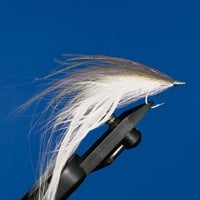
| | Step 5: Apply two coats of Hard as Hull to the head, and paint on white-iris, black-pupil eyes. Or apply stick-on eyes and a final coat of Hard as Hull.|
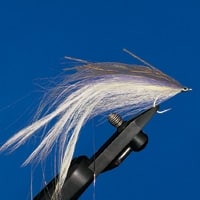
|









